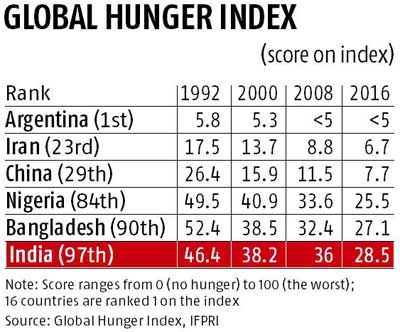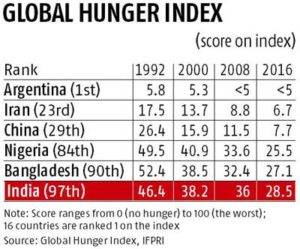India ranked 97th out of 118 countries on the International Food Policy Research Institute’s (IFPRI) Global Hunger Index (GHI) in 2016.
About GHI :
The Global Hunger Index (GHI) is a multidimensional statistical tool used to describe the state of countries’ hunger The GHI measures progress and failures in the global fight against hunger. The GHI is updated once a year.
- The Index was adopted and further developed by theInternational Food Policy Research Institute (IFPRI), and was first published in 2006 with the Welthungerhilfe, a Germannon-profit organization (NGO). Since 2007, the Irish NGO Concern World wide joined the group as co-publisher.
- The 2016 Global Hunger Index (GHI) report—the eleventh in an annual series—presents a multidimensional measure of national, regional, and global hunger.
- It shows that the world has made progress in reducing hunger since 2000, but still has a long way to go, with levels of hunger still serious or alarming in 50 countries.
- This year’s report hails a new paradigm of international development proposed in the United Nations’ 2030 Agenda for Sustainable Development, which envisages Zero Hunger by 2030, as one goal among 17, in a holistic, integrated, and transformative plan for the world.
- In addition to the ranking, the Global Hunger Index report every year focuses on a main topic: in 2016 the thematic focus is on getting to zero hunger.
India’s GHI,
While India has improved its score on various parameters over the past few years, two out of five children below five years of age are stunted in India. Stunting measures chronic malnutrition and affected children’s height would be considerably below the average for their age.
- Overall, the Central African Republic, Chad, and Zambia fared the worst while Argentina fared the best among the countries included in the study.
- It is noted that Pakistan fares even worse and was placed 107 in the GHI list. The report said 22 per cent of Pakistani population was undernourished and that it scored 33.4 on the 0-100 point scale – a marginal improvement from its score of 35.1 in 2008.
- On the other end of the rivalry spectrum, China fares tremendously well despite the sheer size of its population. It is placed 20th with a “low hunger level” rating.
- If hunger declines at the same rate as the report finds it has since 1992, more than 45 countries—including India, Pakistan, Haiti, Yemen, and Afghanistan—will still have “moderate” to “alarming” hunger scores in the year 2030.

- Around half of the populations of Haiti, Zambia, and the Central African Republic are undernourished— the highest in the report. In Timor-Leste, Burundi, and Papua New Guinea, approximately half of children under five are too short for their age due to nutritional deficiencies.
- The positive, however, is that 20 countries, including Rwanda, Cambodia, and Myanmar, have all reduced their GHI scores by over 50% each since 2000. And for the second year in a row, no developing countries for which data was available were in the “extremely alarming” category.
- The country had only the fifth highest rank in the whole of Asia, better than only North Korea (98), Pakistan (107), Timor-Leste (110) and Afghanistan (111).
- Nepal (72), Sri Lanka (84), and Bangladesh (90) had higher ranks among 96 countries than India’s. Also, India had the lowest rank among BRICS nations, with Brazil in the top 16, Russia at 24, China at 29 and South Africa at 51
AffairsCloud Recommends Oliveboard Mock Test
AffairsCloud Ebook - Support Us to Grow
Govt Jobs by Category
Bank Jobs Notification






